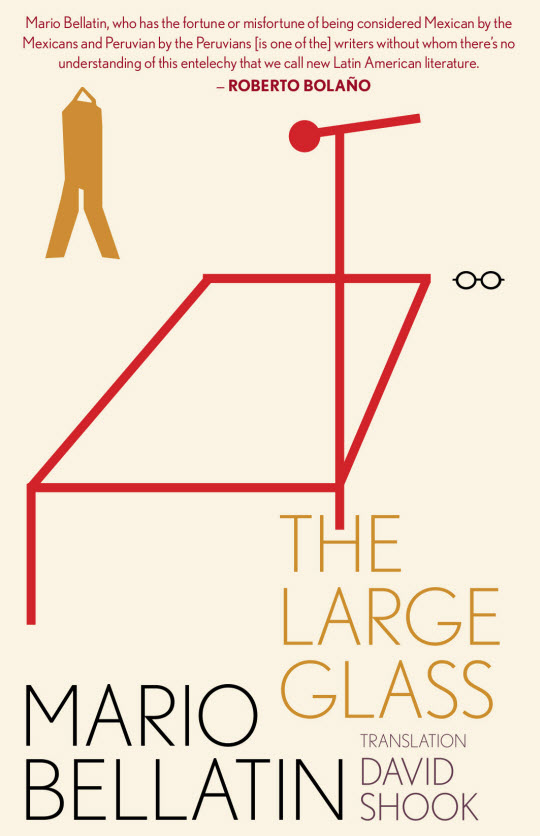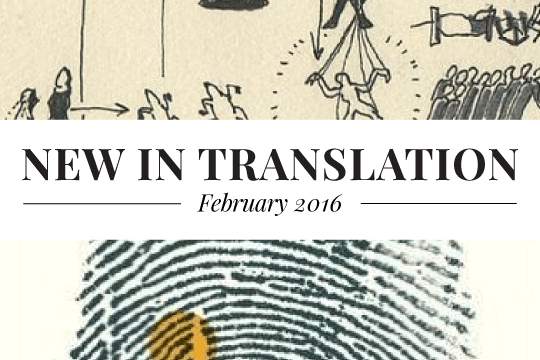Mario Bellatin, The Large Glass (Eyewear Publishing, February 2016, United Kingdom and Phoneme Media, January 2016, United States). Translated by David Shook—review by Alice Inggs, Editor-at-large, South Africa

Can a life be expressed in a single narrative, or a single form; can it be confined to a single genre? Mario Bellatin’s experimental autobiography (or is it autobiographies?), The Large Glass, employs three different ways of writing a life, challenging the accepted idea of what constitutes biography, and therefore self-expression.
This is not the first time Bellatin has engaged with the genre. His 2013 novel, Shiki Nagaoka: A Nose for Fiction, is a satirical biography of a fictional Japanese author, which includes excerpts, photographs and a bibliography. As critic Diana Palaversich explains, “With Bellatin you are never on solid ground”.
The Large Glass is non-linear, and at times almost nonsensical, rendering memory as character. Bellatin’s style has been described as hewing closer to that of avant-garde filmmakers—Lynch, Cronenberg —than anything literary. This brand of inscrutability or opacity—inherent in all three sections of The Large Glass—means that to distil meaning from Bellatin’s work it is necessary to rely on aspects of the author’s “objective” biography. This has something of a Lazarus Effect on Barthes’s dead author. But to what end?
The Large Glass magnifies those fundamental philosophical questions: Are we the same person throughout our lives? How do experiences and the manner in which we experience them and remember experiencing them shape our understanding of ourselves? How do these memories fit into the narrative of a life? Does a life have a single narrative? Bellatin seems determined to “reach that point where only language acts, ‘performs,’ and not ‘me.’”
“My Skin, Luminous”, the first section in The Large Glass, addresses Bellatin’s formative years. Here, the language is plain, unembellished. Clipped descriptions are numbered like verse, or a to-do list. A tally of what is remembered? A litany of trauma? Bellatin recounts his family’s downward spiral into poverty; his mother’s mental illness; his own exploitation at the hands of his mother. Thoughts run together: public bathhouses, soap, genitals, lost siblings and an absent father, his grandfather’s oven, pigs on skewers, trinkets, his mother’s mouth “coloured purple or fluorescent fuchsia”… It’s uncertain whether this is adult Bellatin writing as a child, or child Bellatin thinking like an adult. The narrative ends with a photograph of roasting pigs.
“The Sheikha’s True Illness” deals with health and religion, specifically with regards to Bellatin’s Sufi mentor. A woman suffers from an unknown illness in hospital, echoing the memory of Bellatin’s father’s lover becoming ill in “My Skin, Luminous”, the seeming catalyst for many of the events that followed. In fact, certain ideas within each of the three narratives echo throughout the others. The third narrative, “A Character in Modern Appearance”, incorporates two perspectives: Bellatin and a German girlfriend attempt to locate and buy a particular secondhand car; while a female-Bellatin narrator refutes this narrative by introducing another: she (Bellatin) is really a kind of puppet on display, forced to dance in a desperate attempt to avoid her family being evicted.
Bellatin is seen by critics and peers as an “innovator”, shrugging away Latin American literature’s literary inheritance—realism, both magical and gritty—in favour of the kind of experimentation first seen in the writing produced by the Seventies “boom generation”. In The Large Glass, the question of what is real surfaces again and again. Bellatin’s work raises another problem too: How do you reconcile and then write the multiple selves contained within a life, viewed through the spinning prism of time? This perhaps speaks to larger quandaries about Latin American literature itself: How to write a people, a history, that is not only contested, but multiple.
In The Large Glass, Bellatin begins with the concept of an autobiography. He splits it into three narratives, then starts stripping language and form away until only traces remain. This becomes the outline of a life. An outline that doesn’t confine the life lived to fact, paragraph and memory, but allows for experiences to leak into each other, for selves to emerge and regress, and for the reader to colour the image with their own conceptions. A keen translation by David Shook, finely tuned to Bellatin’s concept, drives home the point: What Bellatin achieves is to show the plurality of being that makes life a mystery, even to oneself.
***
Peter Verhelst, The Man I Became (Peirene Press, February 2016). Translated by David Colmer—review by Beau Lowenstern, Editor-at-large, Australia

‘Today is an important day,’ said the human. ‘Today’ – he curled his lips – ‘we are going to learn how to smile.’
This novel is narrated entirely by a gorilla. He will tell you of his early years in the jungle—that is, a time before he could read and write and chat at parties about ‘this, that and the other’. He will tell you of his capture, his training, his many tests and trials on the path to civility. He will tell you of his work at the amusement park, where he trains the newly arrived animals to perform in a show about the history of civilisation. He will tell you of his fondness for the lion, his forgotten urges, and how all his meetings run smoothly. He will also tell you of the glow on the face of a woman after sunset, of his doubts and dreams, of the empty train tracks that run out of the mountain.
The Man I Became is the eleventh novel by Peter Verhelst and the first of the year’s releases from Peirene Press, a small and highly acclaimed UK-based publishing house. It publishes only three books a year (under a common theme) and is known for featuring high quality English translations of European novellas. Verhelst, a novelist, poet and dramatist of Belgian Flemish origin, has been widely commended since the release of his first novel, Tongkat, in 1999 which won the Ferdinand Bordewijk Prize as well as the prestigious Golden Owl Literature Prize.
The most immediate—and structurally imperative—feature of The Man I Became is its rhythmic cadence. The novella carries a certain forward momentum: a pace that translator David Colmer brings beautifully to the English. The reader has no choice but to be swept along for the ride; a run-away train where light and sound blur into one and the only landmarks are brief and secluded stations along the way—a conversation, the light of the setting sun, a smile. Colmer, a celebrated and awarded translator of more than 50 books from Dutch into English, describes his process: “It’s not so much suspension of disbelief I had to emulate here as absolute belief. The impossible is not implausible, it just is”.
It is this fluency which maintains the absolute conviction of Verhelst’s story-telling. Sweeping certain and obvious details to the side, the reader is allowed brief, remarkable glimpses into his landscape:
Stay sitting where you are a little longer to wait for the stars, which will appear like embers years after the fire has gone out. That too is a miracle.
This style of creating a precise aperture though which the reader can experience a time, place or feeling sets The Man I Became apart from other contemporary renderings of dystopian futures. With Verhelst’s dry humour added to the mix, words jump out and convey a lightness that adds up to an important contrast with the otherwise heavy subject matter.
The story is ultimately one of becoming; exactly what his narrator does become Verhelst leaves entirely up to the reader. The language is swift and subtle, and the vivid scenes play out not merely as words on a page but on an exquisite, imaginary canvas that will stay with you long after the words have faded.
*****
Read more New in Translation:

